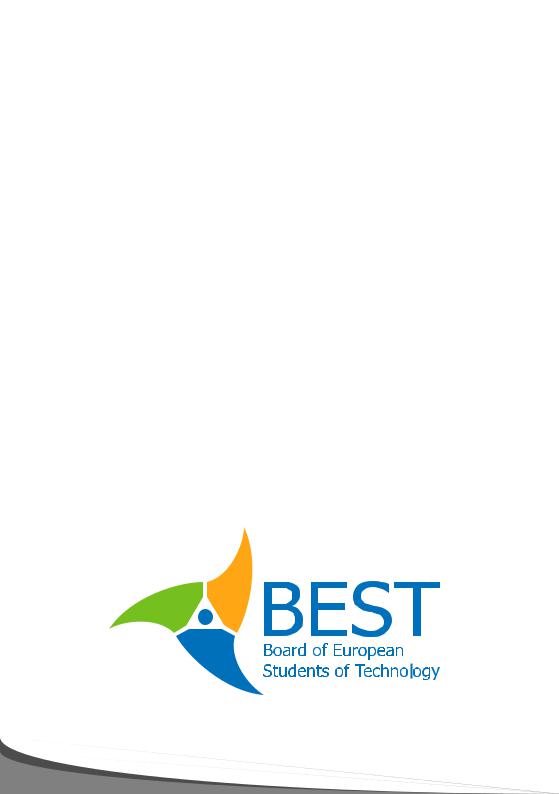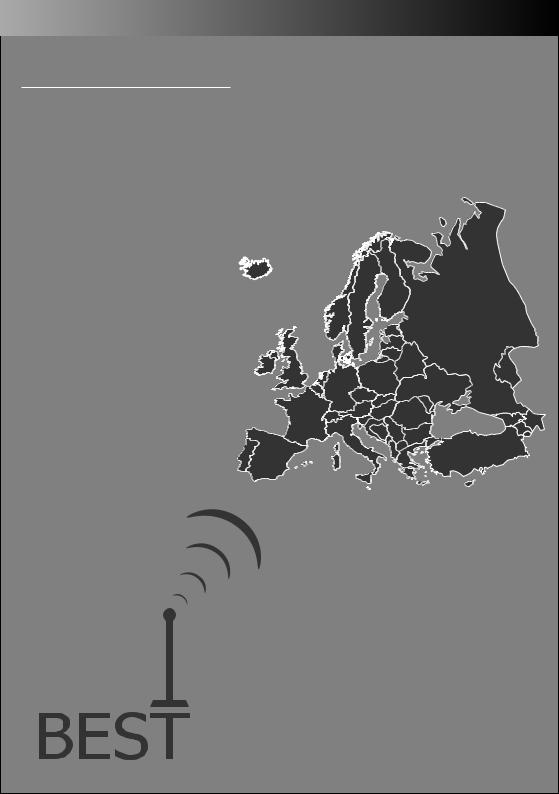
History Book of BEST
.pdf
211
the same graphical face to the world and not each LBG doing whatever they wanted. “ (Mitjia Pirc)
The graphical profile
Even though the logo has not been changed, there was a new proposal at GA 2004
Copenhagen about BEST graphical profile. The document stated the general rules of how the logo should be used, what colours are allowed or that the ratio of the logo rectangle should be 4:3. The proposal to have a graphical profile of BEST was accepted and markeTeam managed somehow to convince the LBGs to use it. There were some exceptions as some
LBGs were keen on keeping the local logo(a mermaid) like Warsaw or specific colours like
Eindhoven(red and blue).
For a certain period of time, LBG Eindhoven made proposals at every GA to change the
Official Green to orange-blue ... they even offered nice quantity of Dutch beer to each voter in 2002.
The Worm proposal
Other tools, like pins, templates (presentation, 1-pager, and webpage) helped also a lot to harmonize identity and gave the LBGs proper tools to promote a unified, European organisation.
The shield
At the same time, during GA 2004 markeTeam was empowered by the LBGs to develop a common image of BEST. As the result, there has been a workshop on the topic. One of the results was the creation of the BEST shields. The idea was to have one shield in the top left corner of the design and one in right lower corner - there would be an inverted shield with the old logo on it in order to slowly replace the old logo. In that spring, members from markeTeam made a proposal for making the shield elements official for BEST, meaning obligatory for all LBGs to use in all BEST materials. As they were made during IPF06 Riga and there was not enough time to show them to LBGs, after a long discussion the proposal

Chapter 7:
BEST Projects
was withdraw-ed. The Shield elements remained as “guidelines” and “it would be good to use”. Still, some LBGs started using them with quite some success, but we were still pretty far away from the common image.
New proposals
Time was passing by and the BEST still needed to find a way to make our visual identity.
The XIX-th board, the Sailors, decided that a Visual Identity for BEST needed to be created, with a good concept .There has been a company with whom BEST collaborated to create a logo proposal for us and they came up with four different concepts, the human concept being one of them.
“The result proposed by the company was probably more fitting to represent BEST outside of BEST than the existing concept (logo + shields / old logo and old font ), but in the same time it was not fitting to BEST inside of BEST. “(Manuel Gay, the Sailors)
However, there was no time for doing proper change management and when the new concept was first presented, BEST was not ready for such a drastic change brought by a third party.
So by the time of GA France 2007 more concepts have been created: the flower power, the leaves and the shields. All the four proposals were presented at GA in 2007; none of them were approved but BEST realised that a change must be done soon in the Visual Identity of the organization.
New VI
The BEST Board restarted the project and elected a new Project Leader in the person of Marian Buhnici from LBG Brasov. Prior to Marian, the task was taken by Christian Banik from Stockholm.
New BEST signature
212

213
In 2007 in September, the Visual Identity Workshop in Timisoara 2007 took place and 19 participants interested in the topic joined to create a new visual identity for BEST. The participants were divided into groups and came up with 5 different ideas. Each of these concepts was explained in detail in a brand book. At PM 2007 in Valladolid, all five concepts were presented to LBGs who voted on the new logo. The proposal of the Star Concept was approved.
After many years of work to create a common image of BEST at a European level, the goal has been finally achieved. There has been a transition period for 1 year assigned in order to give time to LBGs to start using the new logo. This time has also been used for gathering feedback and at GA Tallinn 2008 the BEST Brand Manual together will all those changes were accepted. By GA Budapest 2009 all the LBGs had to implement the new logo and follow the BEST Brand Manual. BEST has made once again a step towards unity!
Article written by Diana Wosik and Mirela Andriescu
Recognition Project
The recognition of BEST Courses represents the official Recognition of the quality of BEST
Courses by the universities. This improves BEST image towards universities, students, companies and other parties. The interest on BEST of all these stakeholders is increasing since our image is getting stronger. Striving for high quality was and still is a long term goal of BEST in order to assure the future survival of BEST. Following the Bologna Declaration, in the near future most European universities will have ECTS-compatible Credit Systems. So far, BEST aimed to find its place in the European Higher Education Area.
The Recognition Project started in 2000, with a joint effort of EduCo and SPOC (now EEC), in order to find a way to have BEST Courses recognised as part of a student’s academic curriculum. After GA2000 Sweden, recognition@ mailing list is created. Following the input gathered in several Discussion Groups, some guidelines and handbooks are produced until 2003. Some LBGs work locally to implement recognition and some in the end manage to get their events recognised defacto (Copenhagen, Louvain-La-Neuve and few others) by agreeing with their universities. At that moment there was almost no coordination from
BEST side. Next big milestone in Recognition project was in PM2002 in Bucharest, where it was decided that since Summer Season 2003 the deliverance of the Course Information Form to the participants of BEST Courses is compulsory. The Course Information Form (shortly CIF) is a paper signed by the university of the organising LBG that mentions all the necessary information that will help participants get credits for the knowledge they got during the event. Among others all the lectures and lecturers are mentioned and also an estimation of the ECTS credits that equal the amount of learning hours during the event.
However the project didn’t move on much longer since around 2003-2004 it became inactive

Chapter 7:
BEST Projects
because the main drivers of the projects retired, the LBGs showed little interest and there was a lack of motivation of SPOC and EduCo members. Finally in EduCo SM 2004 it was decided to put the project on hold. From 2004 and 2005, no further work on Recognition was done. Since Recognition was a long term goal of BESTies though, one year after in summer
2005, EduCo decided to resume the project. Stefan D. was elected Project Coordinator and some preliminary discussion happened. Based on the positive answers from LBGs to the questionnaire at 2005 autumn RMs, it was decided to go further and to have a session about the Recognition project in the International Projects Forum 2006.
In Summer 2006 EEC took full responsibility of the project, having EduCo as a source of information and feedback. During the EEC SM2006 Porto the Project was analysed and later at the BAS Developers Meeting 2006 in Liege the work on recognition was resumed and new progresses were made, like adding a BAS field about the ECTS the courses issue and recognition@ was restructured. A strong promotion campaign started, more input from
LBGs was gathered at RMs and GMs, a new CIF layout was developed and a proposal was approved at GA France 2007 making a university or company stamp compulsory starting from Summer Season 2008. Final steps of the project involve the development of a new CIF that is used since 2008, and also CIFs for engineering competitions and Events on Education. Last but not least a letter from the BEST President was written in order for LBGs to use it in their approach to their deans.
The project is moving on, and year by year more LBGs manage to take new steps towards the recognition of our main service: complementary education.
University Project (Centre)
University Centre is probably one of the most important projects BEST does for students. Its history begins even before BEST was born as an association.
In the International Week in Grenoble in 1988, where the delegates discussed the foundation of a new students association, one of the aims of this organisation was: “make available clear information about every university in the EAU to all interested parties”.
Even if they didn’t know how to do it, it was clear for them that all of the students must have as much information of the educational programmes and offers from the European universities as possible.
The first idea was to make a booklet with the educational offers from the universities members of the organisation. There were some step backs because of financial issues and communication at European level back then.
In the Paris WS in 1995 hosted by LBG ENSTA, the concept of Information Centre was discussed.
The idea was to have a new WWW page in all the LBGs containing the necessary information
214

215
a student coming from abroad to study in a foreign university might need (general introduction, university matters and practical information).
“All the pages, prepared and kept updated at local level in each LBG, should have the same structure, so that the student could easily find what they need, also comparing the equivalent information in different universities. To make it in a very simple way, we have prepared a skeleton that should be filled following this common structure: it contains explanations and examples that just need to be substituted by the text and the links you already have referring to your university. “(WS Paris Report, 1995)
In GA Tallinn 1996, a proposal to approve the structure of the new formed database in WS Paris was presented. Until PM 96, all of the LBGs needed to have their information uploaded in the Information Centre. As this was quite a short DL, the project wasn’t finished in time.
In 2001, during the WS hosted by Cluj-Napoca, the goals and next steps for University Project were discussed.
“On university web page, students will find a lot of information about each university.
Students that will want to study abroad (internships, scholarships, thesis, postgraduate studies, Ph. D, research assistants) will have here the best tool. We will offer them general, statistical and practical information. This will be an information guide for all students that will want to study travel or just to inform.
With UNI project we will help universities to promote their activities to all the students around Europe and also among BEST (and best...) students, who are very active, motivated to learn/work, experienced with working with other people. We will offer the international minded students.” (WS Cluj-Napoca Report, 2001)
A list of expectations from students, universities and companies was made at the same WS. According to that list, the BESTies discussed the detailed structure of the new database for University Project.
The plan was simple on paper, but when it came to implementing a couple of problems aroused. In ICF Timisoara in 2003, these problems were discussed by EduCo and Minerva members.
The main problems of this project were:
•The layouts of the page need to be improve (mT and webteam)
•The questionnaire itself it is difficult to fill in.
•How to present to the university the project in order to convince them to fill in their profile
•Materials needed
They tries to find solutions for each identified problem. After discussing the promotion of the project at Regional Meetings to the LBGs, the delegates concluded that some materials

Chapter 7:
BEST Projects
with information about the project must be disseminated inside the organisation and to the universities. To convince the universities to fill their profile, the LBGs must make a presentation with the benefits of this project.
Although the project was sustained by EduCo and Minerva CMTs, in short time, a new and independent team was created to involve in this project. This way, in 2005 a new mailing list was created to sustain the communication abut this project and in the spring of 2006, the cooperation with ITC started and the coding was in progress. The project should have had 3 databases (universities, offers, city/student life) but the last part was taken out to be independent and called European Travel Guide.
In October 2006 the LBG Admins pages were ready on ParaDe and the first profile was filled in and in November, ITC launch the project for testing by the LBGs. Until February 2007, the FB was implemented but fewer profiles were completed than expected. After discussing with EduCo and Regional Advisers about encouraging the LBGs to set their university profile, a large promotion campaign was made in September towards the
LBGs.
In 2007, at the Unification Meeting in Vienna, ITC and UniPRo members decided to integrate the university profiles into the unified system.
“Academic representative logins should be unified, but after login the representatives should see only the information relevant to each of them:
•Teachers should see courses
•University project representatives with full access should be able to edit the profile and offers
•University project representatives with access only to offers should see only those”
In time, University Project developed into University Centre. Many people both from LBGs but both members of the University Centre team put a lot of effort so that this project comes to an end and students can be better informed about the educational offers of European Universities and not only that . From the ones that dedicated their time and believed in the project are the coordinators of University Centre like Vincent Layec and
Marlene Winkler from LBG Vienna. Although the number of LBGs that have their profile finished has grown, there are still more things needed to be done until all of the profiles are ready and active.
Article written by Mirela Andriescu based on the University Project History wikis
216

217
Virtual International Plenary
In February 2007 fourteen BESTies gathered to a workshop in Ankara. Not only was it the first international event organised by the Local BEST Group from the Turkish capital, it was also the first time when open space technology was applied for the whole workshop. The goal for participants was to find answers to the question: “How does the decision-making process in BEST influence the future of the organisation?”
In an open, brainstorming atmosphere, one of the topics discussed was the efficiency of the decision making process and the effects of the fact that international decisions can be made only twice a year on GMs. Suddenly an idea appeared to create an online voting system for BEST, so decisions could be made much faster. Everybody liked the idea and it was developed further. Martin Varvas from Tallinn became the topic owner, because he initiated the discussion.
It is also interesting to know where the name VIP comes from. It had to be cool and catchy so people would remember it. There were many proposals with words online, virtual, international, voting etc.
Finally, VP - Virtual Parliament was proposed. But BEST was already using VP for Vice Presidents and parliament sounded too political. Then Noelia Bear from Barcelona proposed VIP and everyone agreed with laughter. Then it was only a matter of seconds to find a meaning for I and P.
After the workshop the only toilet with a seat and a plug in the Ankara - Istanbul Express train was occupied by us to write there port. The queue behind the door got quite long, but nothing can stop a true working BESTie. And the report got celebrated well in the restaurant wagon, because the train was four hours late...
Practical history
After these first steps, BESTies needed to kick off the project; most of the work was oriented towards technicalities and fine-tuning. The internal regulations needed to be changed so they would include a new decision making body, which means all details had to be defined and well tested beforehand.
After GA 2007, a new working group started working for this. The first VIP Speaker (Karina
Herman) was announced in September 2007, having a mandate until GA 2008. In this period, the main steps forward were defining a procedure for selecting a deputy speaker, testing the mailing lists (both technically and the way LBG delegates understand to use them), designing the IT system (voting and conduction of the Plenary) and promotion of the project to LBG members. The year between GA 2008 and GA 2009 saw the birth of the IT System, built as a graduation thesis by Diana Daradici, creative solutions for all the issues popping up from the several situational tests for the behaviour of the Virtual

Chapter 7:
BEST Projects
Plenary, clear regulations and enough trust from LBG delegates to make VIP an official decision making body of BEST.
During GA 2009, the proposals to change the regulations for including VIP were approved. The working group, lead by Diana Daradici in the last year, will continue existing for a short period, to ensure support in using the plenary.
Article written by Karina Herman and Martin Varvas
218

History Book of Board of European Students of Technology |
1989-2009 |
Chaprter 8 |
|
BEST and Partners |
|
• Non governmental organizations |
|
• Companies |
|
Chapter 8:
BEST and Partners
BEST and Partners
bonding
bonding is our partner student organisation in Germany that was founded in 1989 by some committed students of engineering and sciences of the technical university of Aachen. Even though their goal is to create contact between students and companies, and even though they were born in the same period of BEST, our roads didn’t cross till the mid 90s. Since May ‘94 LBG Turin had contacts with a German technology student organisation called “bonding”.
Back then, bonding contacted BEST to have a help in the promotion of the European workshop held in September 1994 in Aachen. Since many universities in Germany were target universities for the growth of BEST, it was a great way to connect with German students. After this contact, more and more LBG Turin members went to Germany during bonding company fairs and bonding members attended BEST workshops. The first cooperation plan between BEST and bonding was voted upon in GA1997 in Belgium. It was mentioning cooperation in promotion of the organisations, participation of bonding students to BEST events, and representation of BEST and bonding, in bonding and BEST General Meetings respectively. This cooperation plan also helped the establishment of the first joint project of the two organisations, which was a workshop called ‘Dasa’, organised in Turin. This event was attended by Turin and Berlin students and a German company called Dasa participated and did a case study for these students.
Since this event was characterised as a success, new projects started running, with the next big one being the first summer course organised by a bonding group. The event happened in summer 1998 and it was organised by bonding Berlin. Only 10 participants from BEST universities attended the event, and thus is was not recognised as a learning event.
At the same time, BEST and bonding started collaborating in more areas than those mentioned in the cooperation plan. bonding members were present at the beginning of the Minerva project in 1997 and they introduced Lotus Notes in BEST. BEST members joined a lot of job fairs in Germany and got experience in organising them, while at the same time more courses started getting organised by bonding groups. Lastly, the cooperation in training matters also started rising, and in the summer of 2000 TRAP II was organised in Dresden in cooperation of TIGro and Con Moto, the bonding group dealing with training.
Till summer 2003, more than 500 students from bonding applied to BEST courses and 200 of them had the chance to live the BEST spirit, while at the same time around 150 students from BEST universities had the chance to attend one of the 7 courses organised by bonding groups. A full scale cooperation went on running with more additions in the initial coopera-
220 



